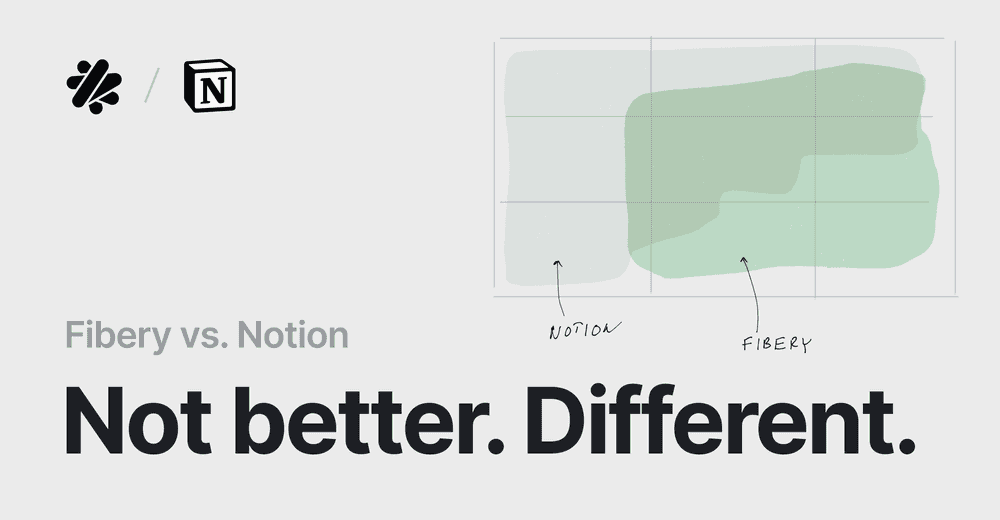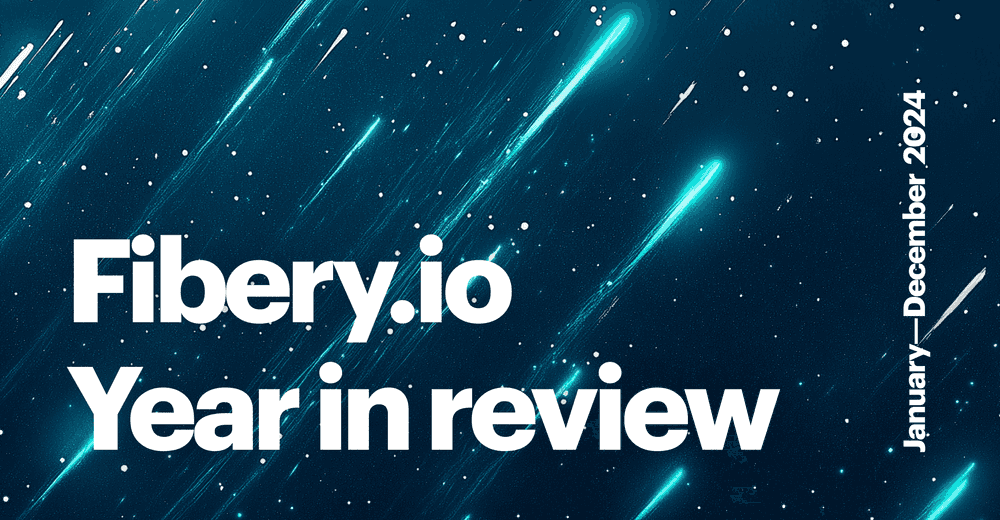Fibery.io Vision V.1: Getting Started

This post is for the early adopters. At this moment Fibery has zero attention to getting started, and the most curious people will find some info here to dig into the Fibery platform.
What is Fibery?
Quick answer:
Fibery is a work management platform that adapts to companies and grows with them.
Long answer is, well, long.
14 years ago I’ve started Targetprocess. It was created to help agile teams run projects. With time it was adopted by 1000+ companies, from small startups to departments in large corporations. I was young and very unexperienced Product Owner. I made many mistakes, but also I learnt a lot. Here are the top three lessons:
- Processes and company structures are changing globally. It is unclear what’s coming next. Tools always behind.
- Every company is unique and has own work management process. Indeed it is becoming harder and harder to generalize requirements, they are quite diverse.
- Every company is changing and its work management process is changing with time. Grows, re-organizations, new departments, new people — all the things that force company to change.
It is quite hard to create a software that can survive serious processes changes and keep up with modern trends.
I think there are two main problems with all work management tools:
- Companies have to change work management tools when they grow.
- Companies use too many poorly integrated tools.
Indeed imagine company evolution. It starts with a very simple tools, like Trello or Google Docs. Around 50 people Trello becomes unusable and can’t support new processes. Company adopts JIRA, Confluence, but still uses Trello for basic processes, like Recruiting tracking or Marketing campaigns. Around 300 people there is a zoo of tools in various departments. You can expect JIRA for software development, Wrike for Marketing, Aha! for product management with some islands of Podio/Trello/etc. Then come heavy vendors, like Microsoft, with their own ecosystem.

I thought about these problems for quite a long time. Is it the best what we can have? Is it possible to create a software that grows with a company? Can it live with a company from a small startup to the large enterprise? Can some work management software do this?

I think it can. Now we have a technology to make this vision a reality. I believe it is possible to build a work management platform that replaces many tools inside a company and grows with the company from startup till the end. This is the grand idea behind Fibery.
Building Blocks
There are five building blocks in Fibery. The most important are 1–4, so I’ll skip #5 for now:
- Custom Domain
- Custom Rules
- UI Components
- Apps
- Workspaces

1. Custom Domain
Companies are unique. It is hard to create a software that fits many of them. Really hard. The most problematic part is a domain. Domain is about entities and relations. In fact this is a non-trivial problem. There are several possible solutions, but all of them have trade-offs.

- Hardcode domain. This is how most vendors do it (Rally, VersionOne, Targetprocess, JIRA). You have Tasks, User Stories, Projects, Bugs, Ideas, etc. Obviously, it is a very strict solution that is not flexible. You have to map company process to strict domain with workarounds and non-intuitive hacks. This solution is rigid. It resists to changes, doesn’t support them. It is anti-agile by its nature.
- Minimal domain. This is how Wrike does it. You have Folders and Tasks. That is it. It is interesting that in real life you can emulate quite many things with just two entities with nested hierarchies, but in the end this approach is not very intuitive as well. It is hard to apply software development work management or recruiting processes to this domain.
- Domain-less. Trello is a good example. It has Boards, Lists and Cards. You can apply your own semantic and live with that. No relations, no hard structure. This approach is perfect for small companies, but it does not scale. Eventually you need more structure: types, relations and hierarchies.
- Custom domain. In theory this is the best solution. It is ideal solution, in fact. Let companies create any domain, add entities and set relations. Why almost nobody did that? Because the solution is hard.
In Fibery we’ve created custom domain, so you can grow it as you wish. You can start small, from basic work management:

And you can end up with more complex domain for several processes:

Custom domain is a very powerful beast, but flexibility comes with complexity. You have to handle this complexity. Later you will see how we did that in Fibery.
2. Custom Rules
Custom domain is not enough. In Targetprocess we’ve learnt that rules inside companies are quite different as well.
Dummy Rule Example:
When Task.State = “Coded” Then Create PullRequestWhat alternatives we have?
- Hardcoded business rules. They tend to obscure logic, spread over various parts of the system and transform it into a clusterfuck. Hardcoded rules aren’t flexible enough (Rally, VersionOne).
- No rules. It means no automation. How to close a Task when all sub-tasks are done? How to notify required people on Task completion? Well, Trello lives happily without rules, but for large companies this automation becomes critical to maintain sane data integrity.
- Custom rules. React on any event inside a system and do something interesting. In fact it is a Zapier inside a tool and this absorption makes perfect sense.
So far Fibery uses option #2, but in the long run we are heading into option #3.
3. UI Components
Third building block is flexible and extendible UI components. We’ve validated this idea in Targetprocess and it works. It is possible to unify visual data representation with just 9 components:

This is it. Every software vendor reinvents the wheel again and again, building own lists, boards, timelines and calendars. Quite often from scratch. Future is not like this.
I believe UI components unification is coming. Tables and Documents are almost unified. They are familiar, they share common UI patterns and elements. The same destiny awaits Boards, Timelines, Lists, Reports, etc. In future business applications will rely on proven unified UI components.
In Fibery UI components are windows to custom domain. You can visualize domain and build powerful Apps.
4. Apps
Fibery mostly consists of Apps. Every App is a combination of Domain, Rules, UI components and (optionally) some code. Apps extends the domain. Here are few examples:



The general App structure is this. As you see, it uses three previous building blocks:

From this point of view Fibery is similar to low-code platform. But it targets very specific problem of work management and doesn’t try to be general solution for all problems. We always think about our platform from work management perspective.
Fibery in Action
OK, let’s move from theory to real life.
NOTE: Fibery is ~10% complete.
We have:
- Basic Apps
- Domain
- Board View, basic Timeline and Calendar
We don't have:
- Rules
- All other Views
- WorkspacesI think most people will use Fibery via Apps. Here is the place where you can install Apps:

This is what happens when you have several Apps installed. Note that you can link entities together between different Apps, this is how you grow the domain and add complexity when needed.

It is time to move from abstract things to concrete examples.
Vacation App

Take a look at Vacation App Domain (bottom right corner on the image above ↑). It has three entities: Sick, Vacation, Dayon. They linked to User entity only.
Now let’s jump to Vacation App. Remember what you’ve read about UI Components? In Vacations App we have just two Views. Here are they:

In this area you can create more Views. Maybe you want to see DayOns for people in specific location. Maybe you want to add a chart that shows how many days people were sick each month. Options are endless.
Now we dig into the Timeline View of Vacation App. This view shows vacations and sick days for all people in Targetprocess company.

What are the benefits of integrated vacation tracker for work management software? There are many. First, you can see who is off right away and plan your meetings and other activities.

Another example: you can display vacation/sick information on a person’s avatar everywhere. Looking at the Feature card (← left) you understand that responsible person is off. You have this information EVERYWHERE and in real life this makes a big difference. You can use this information to plan Iterations, to forecast vacations boom (August?), to improve health of all employees (February is a bad month).
Retrospectives App
Another app is Retrospectives tracking. Imagine you have many teams inside your company and want to track Retrospectives results and keep Action Items in a single place. Here’s how you can do it in Fibery.
In the sidebar there is a list of all Departments and Teams in our company. We are inside Na’vi Team and see some Views. Retro / Action Items View contains all retrospectives and action items for Na’vi team.

Let’s dig in into Retro / Action Items View and check how it looks:

Well, we see that Na’vi team had just one Retro and four action items are there. You can click to other teams and see their Retrospectives as well.
More Apps
Fibery can help with other processes: HR, Kanban, Scrum, Documents management, etc. All in a single tool.


Kanban App: Views, Kanban Board and Features roadmap:



There are many processes Fibery supports. We just started to explore Fibery applications.
Custom Apps
True platform is not possible without custom Apps. You can grow Domain manually in Fibery by adding your own Entities.
For example, you have a Kanban App with Features, User Stories and Tasks. Then you decided that you need one more level of hierarchy — Epic. Let’s add Epic into Domain:
When you have Epic in place, you can add the data and do something like this:

And you may customize sidebar to see Epics and Features as a hierarchy and quickly navigate by Epics.

In a nutshell, you can create Apps in minutes using the following building blocks:
- Entities, Fields and Relations
- Sidebar structure
- Views (Boards, Timelines)
- Access (select Users who can access the App)
In near future we will add:
- Custom Rules (to automate things)
- Metrics (to calculate things)
- Table View (people love spreadsheets!)
- Chart View (Kudos to Vizydrop)
- Custom UI Extensions (for real geeks)
Q&A
When are you going to release Fibery?
We are going to release Fibery in 31 October 2019. 😅 UPDATE: Actually we did that in November 2019
What are your major competitors?
Here is the list:
- Notion. Focuses on Wiki + work management, but management part is quite basic. Hard to scale. It is a good wiki, but not good work management tool. Latest release added something similar to flexible domain as well.
- Podio. Idea is close to Fibery, it allows to manage various domains and processes, but it lacks flexibility and it looks like Citrix almost abandoned this product.
- Zenkit. Idea is close to Fibery, it has several visualizations and something similar to flexible domain. Zenkit does not have narrow focus and supports generic cases. It is loved by users.
- Trello. Still default choice for small teams. Hard to scale above 20 people.
- Asana. All-round solution, but it is not so simple, has serious flexibility limitations and hard to use for company wide processes.
- Airtable. Excel on steroids (works pretty good!). Can be used for the same cases as Podio and Zenkit. Lacks integrations and UI is quite limited for work management.
- Coda. Similar to Notion. Some clever ideas, UI is quite confusing for anything beyond document, but it is on early stage so future is unclear.
- JIRA. You can’t ignore it in work management space.
What is your ideal customer?
We think that it has the following characteristics:
- Startup that doesn’t have heavy tools like JIRA, but manages everything in Google Docs, Trello and Slack.
- Company size: 2–100 people
- Company domain: software development
Next Steps
🐛 Request Fibery Private Beta access: https://fibery.io/
🍄 Join Fibery Community: https://community.fibery.io/
Psst... Wanna try Fibery? 👀
Infinitely flexible product discovery & development platform.


